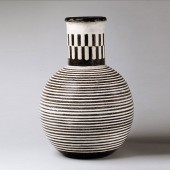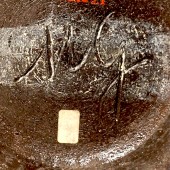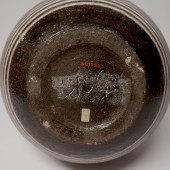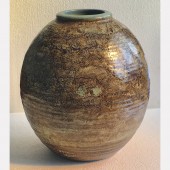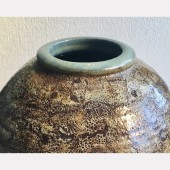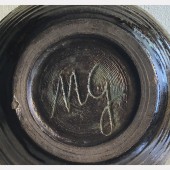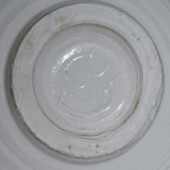![]() Printer version
Printer version
Maija Grotell
1899Born Helsinki, Finland
1973Died Pontiac, Michigan
EDUCATION
1920Graduated, The Ateneum, the Central School of Industrial Art, Helsinki, Finland
1927Immigrated to the United States
1927Summer study, New York State College of Ceramics, Alfred University, Alfred, New York
PRIMARY WORK EXPERIENCE
1927-1928Instructor, Inwood Pottery Studios, New York, New York
1928-1929Teacher for children, Union Settlement, New York, New York
1929-1938Instructor, Henry Street Craft School, New York, New York
1936-1938Faculty and Research Assistant, Rutgers University, Newark, New Jersey
1938-1966Head of Ceramics Department, Cranbrook Academy of Art, Bloomfield Hills, Michigan
BIOGRAPHY
Maija Grotell’s work developed from low-fired figurative pots to simplified geometric forms in stoneware and porcelain. Her work displays a keen awareness of the natural world. She became a master of simple, thrown pots finished using brushed-on, colored slips, glazes and carved surfaces.
Grotell received her initial professional education in Finland at the School of Industrial Art where she studied painting, design and sculpture. After completing this education, she worked for six years with the artist-potter, Alfred William Finch.
In 1927 she immigrated to the United States and began her ceramics studies in a summer-school class taught by Charles Fergus Binns at Alfred University. She settled in New York City, taught at the Henry Street Craft School and independently did research in glazes and Art Deco patterns.
In 1938 Grotell joined Cranbrook as head of the Ceramics Department and, by the time of her retirement in 1966, is credited with reestablishing Cranbrook as a premier clay education program. Among her students were Richard DeVore, Toshiko Takaezu, John Glick and Jeff Schlanger.
In the 1930s Grotell’s surface patterns moved away from geometric designs toward textured fields with linear accents. She favored simple cylindrical and spherical forms, and sought new approaches to their surface treatment. In the 1940s she worked with unglazed colored clay vessels that had tooled or textured surfaces. This approach was also used by Glen Lukens, Marguerite Wildenhain and Laura Andreson. During this period, Grotell continued her research into glazes and glaze problems.
Grotell developed copper reds, ash glazes, intense blues and crackle glazes. She discovered that using a Bristol-type glaze over Albany slip created pits and pin holes unaffected by firing. She worked to control this phenomena resulting in her prize winning Leopard Skin vase (1949).
In the 1950s she worked with merging the two techniques of multiple colored slip layers and the next generation of ‘bubbled glaze’ surfaces. She was able to create an overall highly textured and animated surface by cutting through the surface glaze to the colored contrasting slips beneath.
Her glaze formulas remain part of her legacy. One of her glaze formulas was requested by architect Eliel Saarinen to be used on bricks. This opened the door to the architectural uses of colored bricks in mid-20th century architecture.
The Maija Grotell papers including correspondence, memorobilia and photographic files from a gift of the estate of Maija Grotell, 1974 and 1975, are housed in the Special Collections Research Center, Syracuse University Libraries, Syracuse, New York. A finding aid is available at:
http://library.syr.edu/digital/guides/g/grotell_m.htm.
PUBLIC COLLECTIONS
Art Institute of Chicago, Chicago, Illinois
Brooklyn Museum, Brooklyn, New York
Canton Museum of Art, Canton, Ohio
Carnegie Museum of Art, Pittsburgh, Pennsylvania
Cleveland Museum of Art, Cleveland, Ohio
Cranbrook Art Museum, Bloomfield Hills, Michigan
David Owsley Museum of Art at Ball State University, Muncie, Indiana
Detroit Institute of Arts, Detroit, Michigan
Everson Museum of Art, Syracuse, New York
Los Angeles County Museum of Art (LACMA), Los Angeles, California
Metropolitan Museum of Art, New York, New York
Museum of Arts and Design, New York, New York
Museum of Fine Arts, Boston, Massachusetts
Syracuse University Art Galleries, Syracuse, New York
BIBLIOGRAPHY
Clark, Garth, and Margie Hughto. A Century of Ceramics in the United States, 1878-1978. New York, NY: E.P. Dutton, 1979.
Levin, Elaine. “Maija Grotell." American Ceramics, (Winter 1982).
Levin, Elaine. The History of American Ceramics:From Pipkins and Bean Pots to Contemporary Forms, 1607 to the Present. New York, NY: Harry N. Abrams, Inc., 1988.
Schlanger, Jeff. “Maija Grotell.” Craft Horizons, November/December 1969.
____________. “Working Through the Archives: An Artist’s View.” The NCECA Journal, 1998.
________, and Takaezu Toshiko. Maija Grotell: Works Which Grow From Belief. Goffstown, NH: Studio Potter Books, 1996.
Silberman, Robert. “The First Moderns.” American Craft, February/March 1989.
CV or RESUME: Click Here to Download
Citation: "The Marks Project." Last modified June 5, 2023. http://www.themarksproject.org:443/marks/grotell








